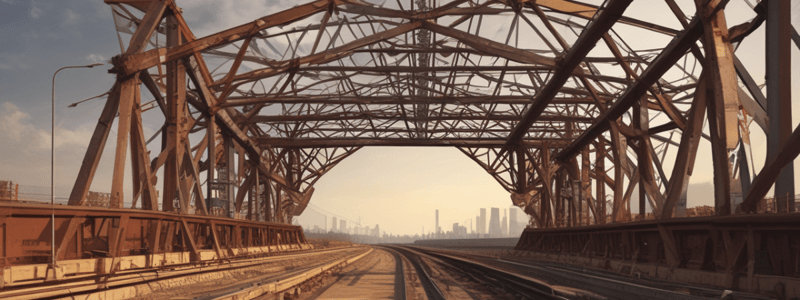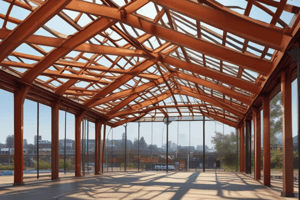Podcast
Questions and Answers
What type of truss has members and joints that are three-dimensional?
What type of truss has members and joints that are three-dimensional?
- Compound Truss
- Space Truss (correct)
- Plane Truss
- Simple Truss
Which type of truss consists of linear elements and can be solved using only equilibrium equations?
Which type of truss consists of linear elements and can be solved using only equilibrium equations?
- Compound Truss
- Space Truss
- Plane Truss
- Simple Truss (correct)
In what way do planar trusses differ from space trusses?
In what way do planar trusses differ from space trusses?
- Their arrangement of members
- Their support conditions
- Their geometry
- Their dimensionality (correct)
What distinguishes compound trusses from simple trusses?
What distinguishes compound trusses from simple trusses?
How are the members and joints arranged in a planar truss?
How are the members and joints arranged in a planar truss?
Which type of truss is commonly used in civil and structural engineering for roof structures and bridges?
Which type of truss is commonly used in civil and structural engineering for roof structures and bridges?
What is the maximum value that the static friction force can reach?
What is the maximum value that the static friction force can reach?
Which type of friction acts to resist the motion once an object starts moving?
Which type of friction acts to resist the motion once an object starts moving?
What type of friction generally occurs when an object rolls over a surface?
What type of friction generally occurs when an object rolls over a surface?
When does fluid friction, or lubricated friction, occur?
When does fluid friction, or lubricated friction, occur?
What does internal friction refer to?
What does internal friction refer to?
In which field is skin friction particularly relevant?
In which field is skin friction particularly relevant?
What is the cone of friction used for in engineering design?
What is the cone of friction used for in engineering design?
How is the angle of internal friction related to the cone of friction?
How is the angle of internal friction related to the cone of friction?
What property of soil describes its resistance to shearing?
What property of soil describes its resistance to shearing?
What helps in determining the size and shape of foundations according to the text?
What helps in determining the size and shape of foundations according to the text?
What is one of the assumptions typically made in truss analysis?
What is one of the assumptions typically made in truss analysis?
Which type of friction opposes the initiation of motion between two surfaces?
Which type of friction opposes the initiation of motion between two surfaces?
What is a significant advantage of the method of sections over the method of joints in truss analysis?
What is a significant advantage of the method of sections over the method of joints in truss analysis?
Which type of truss configuration is named after its respective designer?
Which type of truss configuration is named after its respective designer?
Why is the method of sections more suitable for dealing with complex trusses?
Why is the method of sections more suitable for dealing with complex trusses?
What assumption is made about joint rigidity in truss analysis?
What assumption is made about joint rigidity in truss analysis?
When does static friction come into play between two surfaces?
When does static friction come into play between two surfaces?
Study Notes
Truss Structure
- A truss is a structure composed of straight members connected at their ends by joints, typically slender and arranged in a triangular or polygonal pattern.
- Trusses are widely used in civil and structural engineering to support loads and resist forces.
Classification of Trusses
- Planar Trusses: All members and joints lie within a single plane, the most common type of truss.
- Space Trusses: Members and joints are three-dimensional, extending into space rather than lying entirely within a plane.
- Simple Trusses: Made up of linear elements, statically determinate, and the equilibrium equations alone are sufficient to solve for all member forces.
- Compound Trusses: Composed of simple trusses connected to form a more complex structure, statically determinate or indeterminate.
- Plane Trusses: Members and joints are all in one plane, analyzed using two-dimensional methods.
- Multi-Storey Trusses: Used in multi-storey buildings, supporting vertical loads over several levels.
- Howe Truss, Pratt Truss, and Warren Truss: Examples of different geometric configurations, named after their respective designers.
Assumptions in Truss Analysis
- Joint Rigidity: Joints are assumed to be perfectly rigid, allowing forces to be transmitted only along the members.
- Straight Members: Truss members are assumed to be straight, with any deformations neglected.
- Pin Joints: Joints are considered frictionless and hinged, allowing rotation but no translation.
- No Thermal Effects: Thermal effects are neglected in truss analysis.
Method of Sections
- Advantageous for selective analysis of specific sections or portions of a truss.
- Simpler and more efficient when dealing with isolated members or sections.
- Enables elimination of redundant members, focusing on relevant ones.
- Applicable to complex trusses, simplifying analysis and focusing on critical areas.
- Convenient for handling external loads applied away from joints.
Friction
- A force that opposes the relative motion or tendency of motion between two surfaces in contact.
- Types of friction:
- Static Friction: Opposes initiation of motion between two surfaces.
- Kinetic Friction: Opposes motion of two objects sliding past each other.
- Rolling Friction: Occurs when an object rolls over a surface, smaller than sliding friction.
- Fluid Friction (Lubricated Friction): Occurs when an object moves through a fluid, influenced by viscosity.
- Internal Friction: Resistance to motion within a material, contributes to vibration damping.
- Skin Friction (Shear or Traction): Resistance to motion at the surface of contact between two materials.
Cone of Friction
- A concept in soil mechanics and geotechnical engineering, visualizing the distribution of soil forces around a foundation or object.
- Key points:
- Geometry: A three-dimensional shape extending outward and downward from the base of the foundation.
- Frictional Resistance: Lateral soil resistance is mobilized along the surface of the cone.
- Angle of Internal Friction: Related to the angle at which the cone slopes outward, a property of the soil that describes its resistance to shearing.
- Stability: The stability of a foundation or structure subjected to lateral loads depends on the interaction between the applied forces and the cone of friction.
- Design Considerations: Engineers use the cone of friction concept in designing foundations and retaining structures to ensure stability against horizontal forces.
Studying That Suits You
Use AI to generate personalized quizzes and flashcards to suit your learning preferences.
Description
Explore the concept of trusses in civil and structural engineering, including their geometric arrangement, strength, and stability. Learn about the classification of trusses based on different criteria such as geometry and load-bearing capacity.




